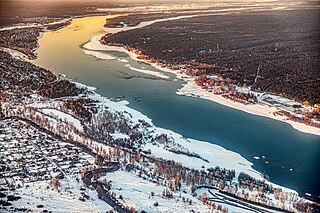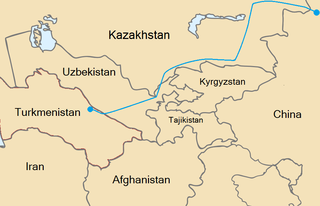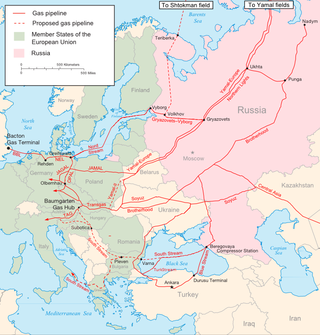Related Research Articles

The Ob is a major river in Russia. It is in western Siberia, and with its tributary the Irtysh forms the world's seventh-longest river system, at 5,410 kilometres (3,360 mi). The Ob forms at the confluence of the Biya and Katun which have their origins in the Altai Mountains. It is the westernmost of the three great Siberian rivers that flow into the Arctic Ocean. Its flow is north-westward, then northward.

PJSC Gazprom is a Russian majority state-owned multinational energy corporation headquartered in the Lakhta Center in Saint Petersburg. As of 2019, with sales over $120 billion, it was, until 2023, ranked as the largest publicly listed natural gas company in the world and the largest company in Russia by revenue. In the 2020 Forbes Global 2000, Gazprom was ranked as the 32nd largest public company in the world. The Gazprom name is a contraction of the Russian words gazovaya promyshlennost. In January 2022, Gazprom displaced Sberbank from the first place in the list of the largest companies in Russia by market capitalization. In 2022, the company's revenue amounted to 8 trillion rubles. In 2023, the company is delisted from international markets, and continues substantial constriction in its operational results.

Barnaul is the largest city and administrative centre of Altai Krai, Russia, located at the confluence of the Barnaulka and Ob Rivers in the West Siberian Plain. As of the 2021 census, its population was 630,877, making it the 20th-largest city in Russia and the fourth-largest in the Siberian Federal District.
The Urengoy gas field in the northern West Siberia Basin is the world's second largest natural gas field after South Pars / North Dome Gas-Condensate field. It lies in the Yamalo-Nenets Autonomous Okrug, Tyumen Oblast, Russia, just south of the Arctic circle. It is named after the settlement of Urengoy. The gas field is operated by Gazprom Dobycha Urengoy and serviced by the town of Novy Urengoy, founded in 1973.

PetroChina Company Limited is a Chinese oil and gas company and is the listed arm of state-owned China National Petroleum Corporation (CNPC), headquartered in Dongcheng District, Beijing. The company is currently Asia's largest oil and gas producer. Traded in Hong Kong and New York, the mainland enterprise announced its plans to issue stock in Shanghai in November 2007, and subsequently entered the constituent of SSE 50 Index. In the 2020 Forbes Global 2000, PetroChina was ranked as the 32nd-largest public company in the world.
Blue Stream is a major trans-Black Sea gas pipeline that carries natural gas to Turkey from Russia. The pipeline has been constructed by the Blue Stream Pipeline B.V., the Netherlands based joint venture of Russian Gazprom and Italian Eni. The Blue Stream Pipeline B.V. is an owner of the subsea section of pipeline, including Beregovaya compressor station, while Gazprom owns and operates the Russian land section of the pipeline and the Turkish land section is owned and operated by the Turkish energy company BOTAŞ. According to Gazprom the pipeline was built with the intent of diversifying Russian gas delivery routes to Turkey and avoiding third countries.
Education in Siberia expanded greatly after the Trans-Siberian Railway was completed in the 19th century. While Siberia became part of Russia in the 17th century it was not until the 20th century under the Soviet Union that education was transformed which in turn brought Siberia to economic importance. This was aimed at uniting people under the Soviet. For example, the Irkutsk State Linguistic University served as "a conduit between Russia and these native people by teaching languages" during the communist era. Imperial Russia began uniting Siberia to Russia by founding Siberia's first university, Tomsk State University, in 1878.

The Yamal–Europe natural gas pipeline is a 4,107-kilometre-long (2,552 mi) pipeline connecting Russian natural gas fields in the Yamal Peninsula and Western Siberia with Poland and Germany, through Belarus. The Poland portion ceased operating in 2022.
The Kazakhstan–China oil pipeline is China's first direct oil import pipeline allowing oil import from Central Asia. It runs from Kazakhstan's Caspian shore to Xinjiang in China. The pipeline is owned by the China National Petroleum Corporation and the Kazakh oil company KazMunayGas.

The Central Asia–China gas pipeline is a natural gas pipeline system from Central Asia to Xinjiang in the People's Republic of China. By connecting Turkmenistan to China’s domestic grid, this pipeline makes it possible to transport gas some 7000 km from Turkmenistan to Shanghai. More than half of Turkmen natural gas exports are delivered to China through the pipeline.
The Eastern Siberia–Pacific Ocean oil pipeline is a pipeline system for exporting Russian crude oil to the Asia-Pacific markets. The pipeline is built and operated by Russian pipeline company Transneft.

Western Siberia or West Siberia is a region in North Asia. It is part of the wider region of Siberia that is mostly located in the Russian Federation, with a Southern part in Kazakhstan. It lies between the Ural region and the Yenisei River, which conventionally divides Siberia into two halves.

The Urengoy–Pomary–Uzhhorod pipeline is one of Russia's main natural gas export pipelines, partially owned and operated by Ukraine. It was part of the "gas in exchange for pipes program" and the Soviet-controlled bank "Ost-West Handelsbank" was opened in Frankfurt on 1 March 1973 to support the project.

The Sakhalin–Khabarovsk–Vladivostok pipeline is a pipeline for natural gas in Russia, transporting Sakhalin's gas to the most populated and industrialized regions of the Russian Far East. It is also projected to become a part of an international export route, carrying Russian gas to East Asian countries, such as the People's Republic of China, South Korea and Japan. The pipeline is owned and operated by Gazprom. It was opened on 8 September 2011.

Power of Siberia is a Gazprom-operated pipeline in Eastern Siberia that transports natural gas from Yakutia to Primorsky Krai and China. It is a part of the eastern gas route from Siberia to China. The proposed western gas route to China is known as Power of Siberia 2.
Yamal project, also referred to as Yamal megaproject, is a long-term plan to exploit and bring to the markets the vast natural gas reserves in the Yamal Peninsula, Russia. Administratively, the project is located in the Yamalo-Nenets Autonomous Okrug.
The Vankor Field is an oil and gas field in Russia, located 130 kilometres (81 mi) west of Igarka in the Turukhansk District of Krasnoyarsk Krai in Eastern Siberia, close to the border with Yamalo-Nenets Autonomous Okrug. Its estimated reserves are 520 million metric tons of oil and 95 billion cubic meters of natural gas. Production was launched in August, 2009. The field is operated by Russian national oil company Rosneft through its subsidiary Vankorneft.

China and Russia established diplomatic relations after the dissolution of the Soviet Union in 1991.

In 2021 Russia was the world's second-largest producer of natural gas, producing an estimated 701 billion cubic meters (bcm) of gas a year, and the world's largest natural gas exporter, shipping an estimated 250 bcm a year. In 2022 the export market collapsed, following the Russian invasion of Ukraine and Russia reducing exports after countries refused to pay in rubles.

The natural gas transmission system of Ukraine is a complex of natural gas transmission pipelines for gas import and transit in Ukraine. It is one of the largest gas transmission systems in the world. The system is linked with natural gas transmission systems of Russia and Belarus on one hand, and with systems of Poland, Romania, Moldova, Hungary and Slovakia on the other hand. The system is owned by Government of Ukraine and operated by Ukrtransgaz. Some local transmission lines together with distribution sets are owned by regional gas companies.
References
- 1 2 "Natural Gas in Exchange for Time". Kommersant. 2006-09-16. Archived from the original on 2007-09-30. Retrieved 2008-12-21.
- 1 2 3 "Altai Project". Gazprom. Archived from the original on 3 October 2010. Retrieved 2010-10-09.
- ↑ Richard Weitz (2009-06-23). "Global Insights: Chinese-Russian Relations the Best Ever?". World Politics Review. Archived from the original on 29 June 2009. Retrieved 2009-07-15.
- ↑ Kelly Zang (2008-10-08). "Russia to delay construction of proposed gas pipeline to China - Xinhua". Forbes . Retrieved 2009-07-15.[ dead link ]
- ↑ "Gazprom, CNPC sign memorandum on eastern route pipeline gas supplies to China (Part 2)". Interfax. March 22, 2013. Archived from the original on 2014-04-13. Retrieved 2014-04-10.
- ↑ Svetlana Kyrzhaly (March 27, 2013). "Gazprom "has forgot" about "Altai", concentrated at the "Power of Siberia" project". Oil and Gas, Metals and Mining News. Retrieved 2014-04-10.
- ↑ "Саммит АТЭС в Пекине: первые итоги - ЭКД!". Archived from the original on 2014-11-29. Retrieved 2014-12-11.
- ↑ "Altai pipeline will go direct from Russia to China". 2014-11-18. Archived from the original on 2015-04-02. Retrieved 2014-12-11.
- ↑ "Russian-Chinese Gas Pipeline Cancellation Offers LNG Opportunities". www.rigzone.com. Retrieved 2019-05-15.
- ↑ "Gazprom and Mongolian Government discuss progress of feasibility study for Soyuz Vostok gas pipeline project". www.gazprom.com. Retrieved 2021-10-23.
- ↑ Pao, Jeff (2022-07-20). "Power of Siberia 2 to divert Europe-bound gas to China". Asia Times. Retrieved 2022-10-02.
- ↑ John Helmer (2008-11-11). "China stumbles in forging Russia gas deals". Asia Times. Archived from the original on 2008-10-07. Retrieved 2009-07-15.
{{cite news}}: CS1 maint: unfit URL (link) - ↑ Meliksetian, Vanand (15 January 2020). "The Superpower Energy Project To Watch In 2020". OilPrice.com. Archived from the original on 5 April 2020.
- ↑ "Алтайская карта "Газпрома"" [Altai map of "Gazprom"] (in Russian). Нефть и Капитал. 2007-01-17. Archived from the original on 2007-02-14. Retrieved 2008-12-21.
- ↑ Pilgrims and Tourists. Earth Island Institute. 2014. 2014 film follows two traditional healers describing cultural impacts of disturbing burial sites. Retrieved 2015-05-15.
- ↑ What Russia’s First Gas Pipeline to China Reveals About a Planned Second One
